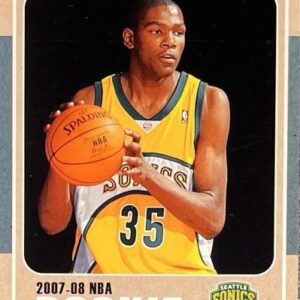In a world where silence often prevails, some things remain relentlessly loud without uttering a single word. Among these, one finds Michael Jordan’s 1995–96 Flair Hot Numbers insert—card number 4—a testament to the greatness of its era. Even before anyone deciphers the number etched on its surface, the card demands attention, boasting vibrant colors and a textured dimension that dazzles under tilting light. It’s a piece of nostalgic brilliance that came to life during the Chicago Bulls’ dynasty years, standing as a vanguard of basketball card supremacy when Flair was on a mission to showcase that premium paper could battle with the chromium titans.
The Beckett guide, the sacred manuscript for card collectors, shares the gospel about Hot Numbers: a refined set of 15 cards that dazzle with a three-dimensional lenticular touch. Each card is a visual masterpiece, edge-to-edge a testament to how a mere piece of cardboard can stir excitement and want, especially during an era bustling with unforgettable 90s inserts.
Yet, like a rare bird in the wild, getting your hands on a Hot Numbers MJ back then was no small feat. These elusive cards were nestled within packs at the rare rate of one in every 36, ensuring that the heart-stopping joy of unveiling one was not just serendipitous, but also a collector’s achievement. This scarcity aligned with its vivid, unabashedly loud presentation gave the Jordan card a well-earned niche in a decade brimming with collectible wonders. Even today, it shouts of the 90s nostalgia, a beacon for anyone familiar with that era’s vibrant design language.
For those who watch the market with meticulous eyes, a PSA 10 grade of this card is akin to a financial headline—one that collectors follow religiously. Recent sales indicate a sparkling apparition, with prices orbiting around four thousand dollars, and a little higher when a card exhibits especially stunning appeal. Take for instance an auction here, a sale there, each marching around the four thousand eight mark, demonstrating the value that both sentiment and condition securely hold.
Ah, the condition—the evergreen conundrum of card collecting. The lenticular face of the Hot Numbers renders faint lines nearly invisible until they’re coaxed into sight with just the right angle of light, while the foil-flashing facade can cunningly conceal minor blemishes. Hence, buyers, in their vigilant quest, rely heavily on dynamic shots, trusted sellers, and a chorus of comparison sales to guide their bids. When one encounters a card presenting with impeccable sharpness and centering, it’s no surprise the offers tumble effortlessly into the aforementioned four-thousand-dollar region.
Design is indeed the glorious specter that dazzles collectors nearly three decades later. It’s the quintessence of mid-90s flair—emanating real movement without relying on holographic gimmickry, and it does so with a richness and depth that outshine its top-loader confines. Spotting one across a card show floor is easy, as its bold geometry and unique numbering burst forth, a signature recognizable to anyone who lived through or posthumously embraced the basketball card renaissance.
Let’s not forget where this card sits in the grand chronicle of card-collecting lore. Flair’s era of production sought to elevate paper, with Hot Numbers at the pinnacle of this ambition—a vivid reminder that not all iconic cardboard shines with a chromium glow. Being a one-in-36 hit placed it in a realm of reverence, a showpiece that non-collectors could respect for its sheer audaciousness and graphic design prowess, far more than just a picture printed on stock.
Collectors can place this MJ in several thematic lanes. It rests comfortably among other illustrious 90s inserts like New Heights and Scoring Kings, graces a dedicated Michael Jordan showcase like the boisterous relative at a family reunion, and fits into a complete Hot Numbers collection—a test of patience and curatorial dedication. Capturing all fifteen cards in pristine condition is a pursuit worthy of a patient hunter, enclosing within each card the echo of mid-90s celebrity fanfare.
Auction trends this year have remained steady, reinforcing the card’s market value with each completed sale. PSA 10 examples point towards four-thousand dollars as the going rate unless a specimen glimmers with exceptional allure or two passionate bidders engage in a bidding war of wills. Unsurprisingly, ambitious buy-now prices and fortress vault listings might seek higher realms, but the true market pulse resonates through auction settlements, where the collective audience speaks.
For those fixated on condition, the tale of this card’s preservation and presentation unfolds under the discerning gaze at angles—the lenticular mask revealing its secrets when sunlight strikes just right, while the calmer backside often divulges wear along its perimeter first. Slabs, those sturdy guardians, simplify grading but can never fully eclipse the discerning collector’s eye. In person, the copies that make statements also demand premium exchanges.
Can this storied slice of history be found today in Galaxy Rip Packs? The answer is a resounding yes. The rotation keeps allowing fortuitous collectors the chance to experience that heart-racing moment reminiscent of 1995, where gatherings ensue and cameras capture the electrifying display that ensues when this card emerges from its cardboard veil.
Owning one of these gems offers dual satisfaction. It’s both a storied design marvel and a financial asset with robust liquidity in top condition. Display it solo to let its vibrant lenticular design bask in isolated glory, or nest it among other 90s treasures to see it hold its ground with charisma intact. Its status is bolstered by scarcity, perfectly timed emergence, and an allure that speaks directly to the universal appreciation for splendid craftsmanship—even when it’s made of cardboard. The joy of holding such a card isn’t just recognized; it’s universally celebrated.






